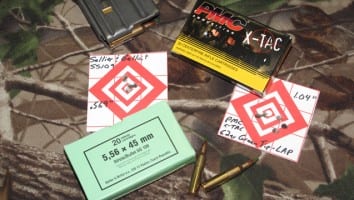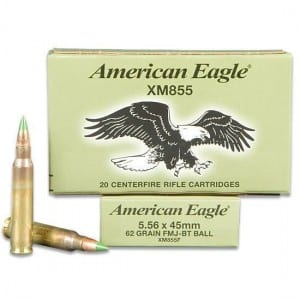
How do commercially available M855 loads perform?
I have honestly never seen the words “Green Tip” and “accuracy” used positively in the same sentence before, but I doubt I am the first guy to discover that certain M855 (and NATO SS109 equivalent) loads are actually good shooters. When I was still a Joe, one Green Tip round was as good (or bad) as the next, and if I happened to shoot a decent group once in a while, I figured it was a fluke. I mainly concerned myself with reliability, holding zero and hitting people-sized targets. Since retiring from the military, I have realized U.S.-made M855 is at the bottom of the heap when compared to some foreign equivalents.
Many sources for this ammo have been made available from both commercial manufacturers and U.S. surplus stocks in recent years, thanks in part to the U.S. Military’s transition to the M855A1 (non-toxic) load. I will not retread the well-worn ground surrounding the M855 projectile’s lethality here. Instead I will simply compare eight loads I purchased on the commercial market, looking specifically at reliability, accuracy and velocity.
Before I dive into the test methodology and results, a little background about this cartridge is in order. NATO adopted SS109 around 1980 as the standard 5.56×45 mm load. The 62-grain projectile is of Belgian design and uses a closed-nose, copper-jacketed lead core. A steel penetrator is incorporated into the core during the manufacturing process, which helps this bullet penetrate very thin, mild steel out to medium ranges.

I had an opportunity to watch M855 projectiles being produced from scratch at the Lake City Arsenal several years ago, and I was surprised to learn that the penetrator is more of a cup than a solid steel slug. It is not an armor-piercing round, and it is perfectly legal to own as far as the federal and most state governments are concerned (check your local laws). As a general rule of thumb, the more components you jam into a bullet, the greater the chance for inconsistencies from one projectile to another. It is apparent from my accuracy testing that some manufacturers are more careful than others.
One of the tested ammunition brands (Olympic) no longer appears to be available. I bought 1,000 rounds long before bulk Green Tip buying was in vogue and used my last bit for this test. Two other loads I wanted to include in the test were unavailable: Radway Green (UK) and IWI (Israel). I have heard the British loads are underpowered while the Israeli ammunition is a bit hotter than most, but was unable to verify either claim.
I used a Citizen Arms Eastern Predator 16-inch-barreled carbine as the test bed for this effort. This is a fighting gun, but its 1:8-inch twist, mid-length-gas barrel regularly shoots Black Hills 55-grain MPG and 77-grain Match into sub-.75-MOA groups at 100 yards using a 4X optic. I chose the new Bushnell 1-6.5X24 mm first-focal-plane scope for this effort, finding it to be well suited for accurate shooting. I used an Oehler 35P chronograph, because I really wanted to check each load’s velocity consistency.
The M855 data sheet from ATK (which currently operates the Lake City Army Ammunition Plant) shows a velocity range of 3,000 (+/-40) fps. Presumably, that number is obtained through 20-inch test barrels. While only one of these loads topped 3,000 fps when fired through my 16-inch gun, a total of four fell within ATK’s range, for whatever that’s worth.
Two points should jump out of the results in the table below. First, average muzzle velocity is in no way indicative of 100-yard accuracy. Velocities are scattered throughout the results, which are listed according to accuracy rank. The fastest load tied the second slowest cartridge for first place. Higher-velocity cartridges gain their edges further downrange due to less time for gravity and wind deflection to affect trajectories. In many cases—Green Tip included—high velocity also equates to more tissue damage due to specific projectile design characteristics. Sometimes, this is intentional and sometimes it comes by fluke, as with M855’s cannelure, which serves as a high-velocity fracture point. Handloaders know well that pushing things to go faster often results in diminished accuracy, so a balance between velocity and accuracy with any projectile/barrel combination must be found.
The other glaring result from my test should come as no surprise: lower standard deviations (SD) in velocity usually yield better accuracy. If you can see substantial variation at 100 yards/meters, it will show up in spades as distance increases.
No malfunctions were encountered during testing. The barrel and chamber were cleaned between brands and time was spent re-zeroing each load. A total of 90 rounds of each ammunition type were fired, for a total of 720 rounds. While far from comprehensive, this comparison provides a decent snapshot of what to expect from each product.
Love it or hate it, there is a bunch of M855/XM855/SS109 floating around on surplus and commercially-manufactured markets. If you like Green Tip, it is good to know some of it is accurate enough to be relied upon for tough shots out to moderate distances.
M855 / XM855 / SS109 “Green Tip” Ammunition Comparison
| Load | Muzzle Velocity (fps) | Standard Deviation (fps) | Smallest Group (inches) | Largest Group (inches) | Group Average (inches) |
| Sellier & Bellot SS109 | 3,006 | 10 | 0.57 | 1.8 | 1.1 |
| PMC X-Tac Green Tip-LAP | 2,899 | 17 | 1 | 1.4 | 1.1 |
| Prvi Partisan M855 | 2,944 | 24 | 1.2 | 1.7 | 1.4 |
| Olympic SS109 | 2,993 | 24 | 0.7 | 2 | 1.4 |
| Lake City Arsenal M855 (’11 headstamp) |
2,978 | 25 | 1.4 | 2.8 | 2 |
| American Eagle/Lake City XM855 (’11 headstamp) | 2,951 | 28 | 1.6 | 3.2 | 2.1 |
| Double Tap Ammunition SS109 | 2,871 | 28 | 1.7 | 3.6 | 2.6 |
| Winchester M855 | 2,990 | 27 | 2.9 | 4.4 | 3.7 |
All loads tested using a Citizen Arms Eastern Predator 16-inch-barreled Carbine with a Bushnell Elite Tactical 1-6.5X24 mm scope with BTR-2 reticle.
Velocities measured using an Oehler Model 35P positioned 15 feet from the muzzle for 10 rounds per load.
Accuracy testing performed at 100 yards from a prone-supported position for five, five-round groups per load.


